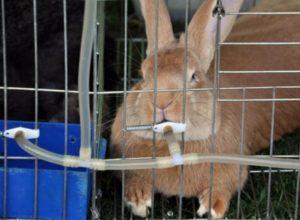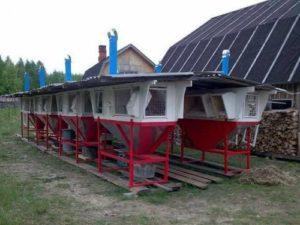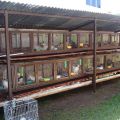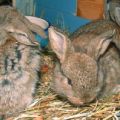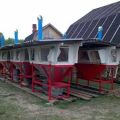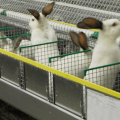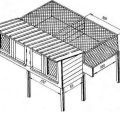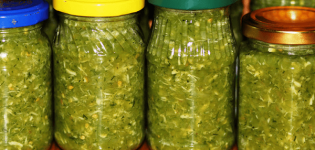Rules for raising rabbits for meat at home
Raising rabbits at home is aimed at obtaining meat with high dietary and taste qualities, and skins. Meat animals are raised somewhat differently than fur animals, the differences lie in the composition of the diet. It is important to feed the rabbits so that they gain sufficient weight before slaughter and remain healthy, therefore the diet is varied and balanced, including dietary supplements and vitamins.
Popular breeds
Breeds should be grown for meat, the representatives of which are distinguished by a large physique and significant muscle mass:
- The New Zealand breed is the most popular of the meat breeds. Already 3-month-old individuals weighing more than 5 kg are sent for slaughter. Meat in relation to live weight is about 60%.
- Californian is a young breed. The weight of 3-month-old rabbits reaches 4 kg. The mass of meat is 55% of the live weight.
- The gray giant is a popular breed all over the world. Animals grow rapidly, reaching 6-7 kg by the age of 3 months. But the taste of the meat is average.
- The Soviet chinchilla is a breed whose representatives are distinguished not only by their rapid weight gain, but also by their valuable fur coat. An adult animal weighs 6-8 kg.
Methods of raising rabbits for meat
How to keep the animals, the owner chooses taking into account the climatic conditions in the region where the farm is located. Rabbits feel great in the fresh air, but in summer they can get a sunstroke without a canopy, and in winter, when frost is down to -20 ° C, they can freeze without insulation. The best option for placing rabbitries is in a bright area, where there is no strong wind, but there is ventilation and diversion paths for animal waste.
Cells
The most popular option for novice farmers. The cages are easy to clean, insulate and move. To start breeding rabbits for meat, you need to make cages of optimal sizes:
- length - 120 cm;
- height - 40 cm;
- width - 60 cm;
- distance from the ground - 60 cm.
One rabbit has enough space of 0.08-0.1 m2... In one structure, 6-8 young individuals of the same sex are kept. Young animals are left with their mother until 2 months of age, and males are kept separately one by one.
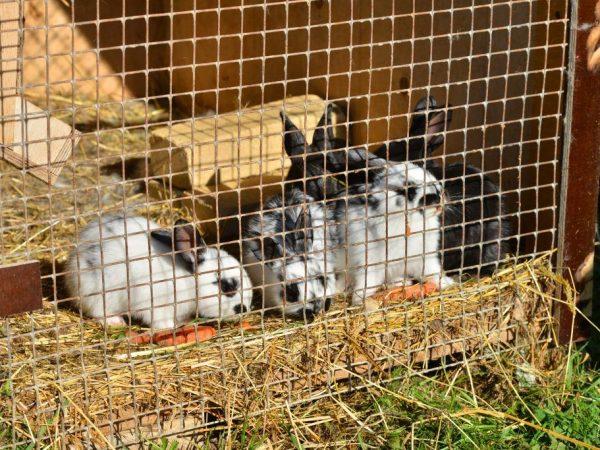
Cages are made of wood, fiberboard, plywood. The material is covered from the inside with metal plates or a fine mesh so that the rabbits do not gnaw their home. The roof is made of slate or ondulin, it is imperative that a slope is made so that rainwater flows to the back wall.Sawdust, foam plates, dry leaves, building thermal insulation materials are used as insulation.
Aviaries
Fenced areas with the following parameters:
- area - 1 m2 for one animal;
- mesh height - 1.5 m;
- groundwater - deeper than 2 m;
- deepening of the fence from the tunnel - not less than 60 cm;
- territory - elevated with the presence of a runoff;
- weather protection - canopy;
- shelters - houses;
- draft protection - one blank wall out of four.
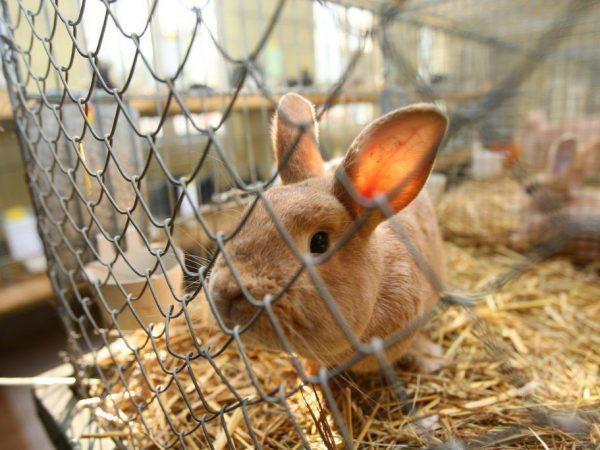
With an open-air cage growing method, less effort and time is required to care for pets. But there is a drawback - the complexity of monitoring the health of animals (it is enough for one rabbit to get sick for the whole livestock to catch the infection).
Pits
Pits are dug up to 2 m deep, and several rabbit families are launched into them. The parameters of such a dwelling:
- territory - elevated, shaded;
- size - 2 × 2 m per 100 individuals;
- bottom - sandy, to a depth of 20 cm, covered with a fine mesh, covered with straw;
- walls - slate, mesh or cement, with a single tunnel hole;
- the entrance to the hole is closed by a door that can block the exit from the hole;
- protection from precipitation - a canopy with a slope;
- the distance between the pits is at least 20 m.
The advantage of this content is ventilation in the absence of drafts. The downside is the crowding of rabbits, which creates the danger of an epidemic outbreak.

Sheds
The best option in regions with a mild climate and frost-free winters. Sheds are non-insulated long frame structures with a roof. Rabbit houses are in a row, and in the middle there is a long corridor. The design is convenient and simple, saving space.
Mini Farms
The cages are placed in 2 or 3 rows inside a room that is ventilated and heated in winter. Feeding and water supply, cleaning and ventilation are provided automatically, human work is minimized.
A big plus of such farms is that in the absence of a person, rabbits are less stressed, they grow faster.
Diet of rabbits when fattening for meat
The diet of rabbits includes food:
- green - herbs and twigs;
- juicy - silage, root vegetables and vegetables;
- rough - hay;
- concentrated - bran, grain, cake;
- animal - fish oil, bone meal.
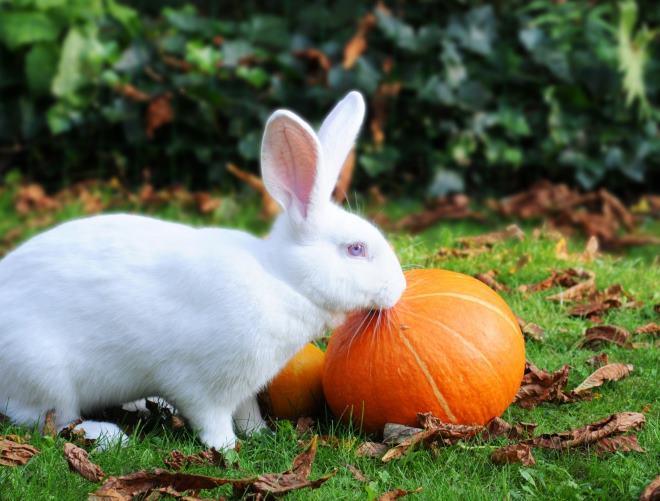
Rabbits drink a lot, so drinkers should always have clean water.
Summer diet
After winter, the rabbits are gradually transferred to summer food, dry food is replaced with green one. In the first days, add 50 g of greens per individual. After 10 days, the amount of green food should already be 500 g, and after 2 weeks - 1 kg. It is impossible to abruptly transfer animals from dry to green food, otherwise life-threatening flatulence may occur.
If the grass is wet from dew or precipitation, then it must be dried before placing it in the trough.
On hot days, rabbits eat mostly in the morning and evening. The summer daily portion for an adult rabbit should be 800 g of grass and 30 g of concentrates.
Winter food
The basis of the winter food for rabbits is hay. The diet includes animal products (fish oil, bone meal). They supplement the winter diet with juicy roots (potatoes, Jerusalem artichoke), they contain a lot of nutrients and nutrients, thanks to which rabbits grow faster.

Approximate percentage distribution of feed in the winter diet:
- hay - 40%;
- compound feed - 30%;
- juicy feed - 20%;
- concentrates - 10%.
Vitamins and mineral supplements
In order for rabbits to grow quickly for meat, they are given growth stimulants containing vitamins and bioactive substances. The preparations are added to grain mixtures.
Stimulants are recommended:
- Fos-Bevit;
- Flavomycin;
- Nucleopeptide;
- E-selenium.
Also, farmers use vitamin and mineral complexes:
- Eshka;
- Chiktonik;
- Zdravur;
- Eleovite.
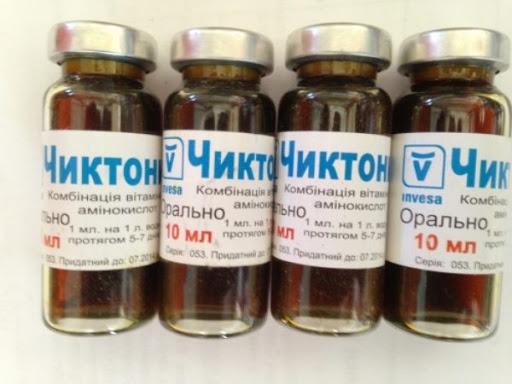
If a complete feed is used for feeding for meat, then additional sources of vitamins and minerals are not needed, otherwise the animals will develop hypervitaminosis.
Feed for slaughter
Feeding for meat does not mean that rabbits need to be fed frequently and often. They begin to feed animals intensively a month before slaughter. Moreover, the feeding period is divided into three stages, differing in diet:
- Preparation stage. The basis is the most high-calorie food. Greens and juicy feed are added, the portion of compound feed is increased by 1.5 times. In winter, reduce the portion of hay and twigs. Recommended products - grain concentrates, carrots, beets, Jerusalem artichoke, clover, legumes.
- Fattening stage for meat. A diet is selected that promotes the rapid deposition of fat mass. Minimize the amount of hay and twigs. Vegetables are excluded, only boiled potatoes are left, which is mixed with mixed feed, bran, cake. They provide peas, corn, barley and oat grains.
- Weight maintenance phase. Eliminate hay and greens, they will make the rabbit meat tough. The basis of the diet is boiled potatoes with mixed feed, grain, and bran. Give some twigs. To stimulate appetite, use parsley, dill, caraway seeds, add some salt to drinking water (a pinch per 1 liter).

Annual feed requirement
The table shows the annual feed requirement for combined feeding, which allows you to calculate the cost of rabbit meat. The indicators need to be multiplied by the feed prices. The requirement is given for a female rabbit that gave 4 offspring (24 cubs) per year for meat.
| feed | annual amount, kg |
| compound feed | 340 |
| hay | 110 |
| roots | 90 |
| grass | 420 |
What can not be fed
Rabbits can be fed with cabbage, but only fodder, and not fresh, but slightly lethargic, so that the pets do not have digestive problems.
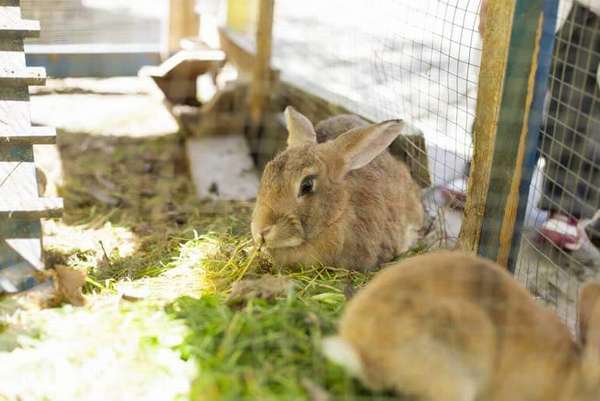
It is strictly forbidden to include in the diet:
- young green potatoes;
- sunflower seeds in large quantities (a few raw seeds are enough for a treat);
- herbs high in esters (basil, mint, lavender);
- nuts;
- dairy products;
- meat;
- chocolate sweets, pastries.
Possible diseases
Raising rabbits for meat is difficult, as they are prone to eating disorders associated with poor quality or inappropriate feed choices. Symptoms are loose stools or constipation, and bloating. Eating disorders are treated with a 12-hour fast, then soft foods are gradually introduced. Digestion is improved with a little castor oil. For diarrhea, Syntomycin is given 2 times a day (a tablet for 2 liters of water).
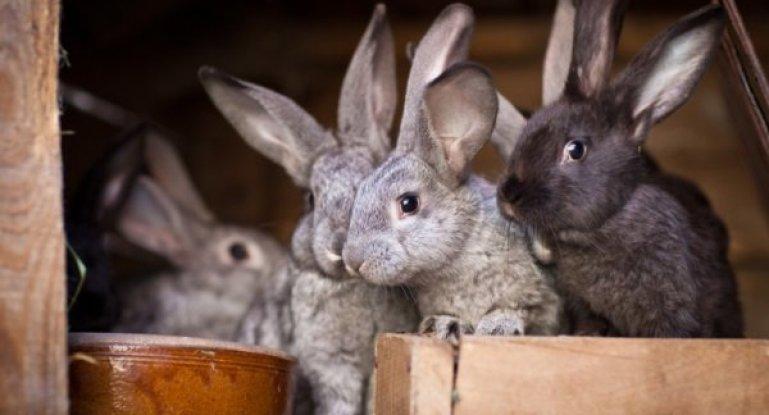
A rabbit with a cold sneezes, and fluid flows from the nose. The sick animal is kept warm, Furacilin is instilled into the nose (1 g of the drug per 100 g of water).
Infectious diseases of rabbits include:
- myxomatosis;
- coccidiosis;
- hemorrhagic disease;
- ear mite.
A veterinarian deals with the treatment of infectious diseases. The owner must isolate the sick pet, disinfect the cage.
Reproduction
Puberty begins at different times in different breeds. The earliest maturity is 4 months. But, on average, rabbits are ready to breed by 6-8 months. Previously, rabbits should not happen, as a too young female may have problems with milk production or a miscarriage may occur. You can breed rabbits for meat all year round, but the strongest offspring are born during the colder months.

You should not choose for mating individuals:
- from one litter;
- obese patients;
- who have undergone vaccination less than 20 days ago;
- females prone to devouring newborn babies;
- females with undeveloped or defective nipples.
Slaughter
The optimal time for slaughtering rabbits for meat is at the age of 7 months. To improve the quality of meat, it is advisable to castrate males 2 weeks before slaughter. The rabbit is killed by hitting the nose, back of the head or forehead with a blunt, heavy object.The animal is taken by the hind legs with the left hand, and with the right, swinging strongly, they beat on the back of the head under the ears. This separates the skull from the cervical vertebrae. The carcass is hung on a spacer, skinned, gutted, blood is released.
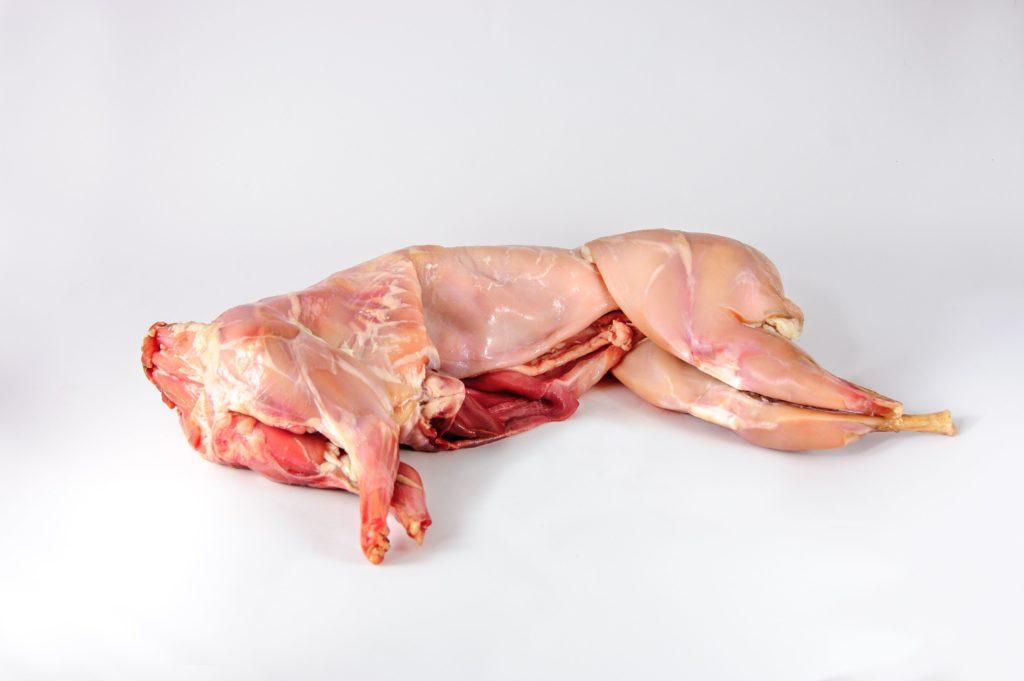
How long do rabbits grow from birth to slaughter
Growth time to slaughter weight depends on the breed, but, on average, rabbits are fattened for meat for 3-7 months from birth. New Zealand and Californian pets reach the required weight faster.
Adult animals (old and no longer fertile) are fattened for meat within 5 weeks.
Growing profitability
Raising rabbits for meat at home is cost-effective if you consider the following guidelines:
- vaccinate animals in a timely manner to prevent death;
- advertise products in any way possible;
- sell not only meat, but also skins;
- more often females with males, in order to buy young animals less often;
- buy new animals not in the market, but from experienced farmers, so the probability of getting sick and defective animals is lower;
- before starting a business, draw up a plan, calculate the payback period.
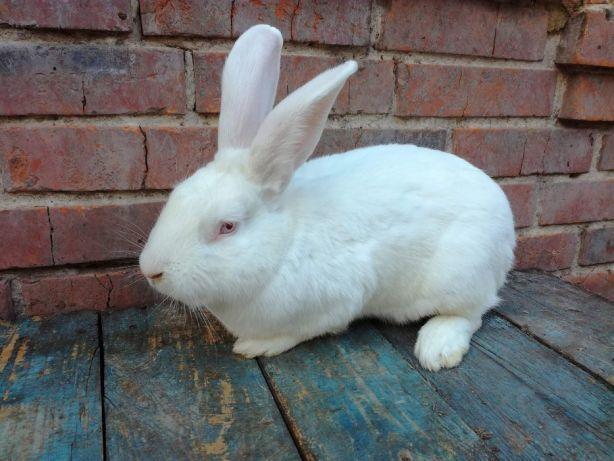
The mistakes of inexperienced farmers
The profitability of raising rabbits for meat is reduced when new farmers make the following mistakes:
- inadequately feed animals, while exhausting them with frequent mating;
- give compound feed intended not for rabbits, but for pigs or cattle;
- rabbits are slaughtered inopportunely, which leads to a reduction in space in the cages and excessive consumption of feed;
- make the cages too spacious - rabbits are actively moving, which is why they gain weight poorly;
- do not vaccinate animals, do not carry out preventive disinfection of premises;
- healthy and frail rabbits are not properly distributed in cages, causing some to get more food than others.
Rabbits raised for meat must receive high-quality and balanced feed, otherwise the farmer will face developmental delays and sickness of animals, which means he will incur losses.
